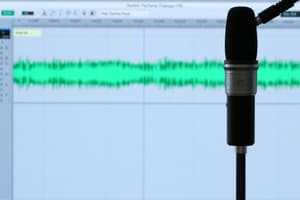Podcast
Questions and Answers
What is a common consequence of a high dynamic range in an audio track?
What is a common consequence of a high dynamic range in an audio track?
- The track will have a consistent volume level throughout.
- The loud parts of the track will be distorted.
- The quiet parts of the track may be too quiet, requiring volume adjustments. (correct)
- The track will have a low overall volume.
In Audacity, where can you find the compressor effect?
In Audacity, where can you find the compressor effect?
- View -> Volume and Compression -> Compressor
- File -> Import -> Compressor
- Edit -> Volume -> Compressor
- Effect -> Volume and Compression -> Compressor (correct)
What does a compressor do to the dynamic range of an audio track?
What does a compressor do to the dynamic range of an audio track?
- It has no impact on the dynamic range; it only adjusts the overall volume.
- It increases the dynamic range, making quieter parts quieter and louder parts louder.
- It completely removes the dynamic range, making audio at a constant level.
- It reduces the dynamic range, making the difference between quiet and loud parts less significant. (correct)
What is the primary difference between a compressor and a limiter?
What is the primary difference between a compressor and a limiter?
A user has applied a compressor effect in Audacity, making the overall audio quieter. Which additional step should they take?
A user has applied a compressor effect in Audacity, making the overall audio quieter. Which additional step should they take?
Flashcards
Dynamic Range
Dynamic Range
The difference between the loudest and quietest parts of an audio track.
Compressor
Compressor
An audio effect that reduces the dynamic range of a sound by making loud parts quieter and quiet parts louder.
Threshold
Threshold
The level at which the compressor starts to reduce the signal's volume.
Ratio
Ratio
Signup and view all the flashcards
Limiter
Limiter
Signup and view all the flashcards
Study Notes
Dynamic Range Control in Audacity
- High dynamic range audio can cause listener discomfort due to large volume fluctuations.
- Audacity offers tools to reduce dynamic range and increase audio loudness.
- Volume and Compression -> Compressor effect reduces dynamic range.
- Compressor reduces sounds above a set threshold by a specified ratio.
- This reduction requires adding "make-up gain" or normalisation.
- "Knee width" and "smoothing" parameters minimise distortion.
- Use factory presets for initial adjustment.
- Master effect or real-time mode for visualizing adjustments.
Compressor vs. Limiter
- Compressor vs. Limiter: Both reduce loudness, but the limiter is stricter.
- A compressor may allow sounds to temporarily exceed the threshold, while a limiter prevents any sound exceeding the threshold.
- A compressor uses a low ratio, while a limiter is harsher in its approach.
- Both effects benefit from factory presets to get started.
- Master effect mode allows for real-time monitoring.
- Use limiter to avoid clipping.
Studying That Suits You
Use AI to generate personalized quizzes and flashcards to suit your learning preferences.




